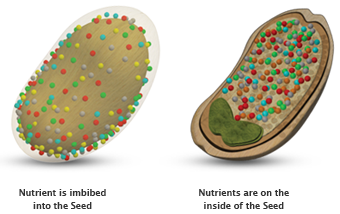
Soil salinity is a serious problem in Pakistan that reduces the crops yield. In Pakistan, about 6.281 million hectares of land are salt-affected, out of which 1.89 million hectares are saline, 1.85 million hectares are permeable saline-sodic, 1.02 million hectares are impermeable saline-sodic and 0.028 million hectares are sodic in nature. It is estimated that out of 1.89 million hectares saline patches, 0.45 million hectares are in Punjab, 0.94 million hectares in Sindh and 0.5 million hectares in KPK.
Salinity affects the seed germination either by creating an osmotic stress thus prevents the seed to uptake the water or through the toxic effects of sodium and chlorides ions on the germinating seed. The interactions of salts with mineral nutrients may result in nutrients imbalance and their deficiencies in plants. Both salt and osmotic stresses are responsible for inhibition and delaying of seed germination as well as seedling establishment of major field crops such as wheat, maize and rice.
Recent research has identified more than 1500 plant species that have high levels of salt tolerance, are called halophytes. These plants are the major resource that can be used in the development of an agricultural system for salt affected soils. In addition, there are opportunities to increase salt tolerance of existing crops using conventional plant breeding and molecular biological approaches. Besides intensive research efforts, success rate is low due to many constraints. Output achieved is much less as compared to time and money exhausted. So there is a need to pioneer cost effective and farmer friendly strategies. Less germination percentage and reduced plant population is a major setback under saline conditions, so improving seed emergence and seedling establishment is the only cure to problem.
Seed priming; a pre-sowing seed treatment, is best fit in this scenario. Seed priming is a controlled hydration process followed by re-drying that allows pre-germination metabolic activities to proceed rapidly. Salinity tolerance of plants can be improved by treating seeds with solutions of different salts before sowing, as plants from such treated seeds show more adaptation to saline conditions than the untreated seeds. There are several approaches under the umbrella of seed priming to improve the performance of the seeds under saline condition.
Hydropriming is a process in which seeds are soaked in aerated distilled water and after soaking seeds are dried to original weight with forced air under shade. Hydropriming improved the germination percentage and grain yield of wheat, rice and maize seeds under saline conditions compared with non-primed seeds. Hydropriming in maize not only increased the speed of seedling emergence, improved the plant growth but also seeds completed 50 per cent germination and mean germination in lesser time. It also improved achene yield in sunflower, however, plant height and achene oil contents remained unaffected.
Osmopriming is a process in which seeds are soaked in aerated solutions of low water potential; seeds are re-dried near to original weight after soaking with forced air under shade. Osmopriming with CaCl2, NaCl, succinic acid and ZnSO4 improved emergence and early growth of sunflower in field. The improved seedling vigor was associated with enhanced oxygen uptake, increased amylase activity and the efficiency of mobilizing nutrients from the cotyledon to the embryonic axis. In maize, seed priming with CaCl2 was found to be more effective to alleviate the adverse effect of salinity stress at germination stage than priming with other salts like NaCl or KCl.
Ascorbate priming is the soaking of the seeds in aerated solution of ascorbic acid. Seed priming with ascorbate is a useful approach to obtain better direct sown rice crop. Ascorbate priming improved the field emergence, allometric response, kernel yield and its quality than non-primed seeds in rice and also improved wheat performance under saline condition.
Plant growth regulators are organic compounds which are produced in very small amount in plant and play an important role in growth, development and yield of crops under saline conditions. Different plant growth regulators including in dole acetic acid (IAA), salicylic acid (SA), gibberelic acid (GA3) and kinetin, are used for priming purpose. Hormonal priming of wheat seeds with SA or ascorbic acid enhanced the germination and seedling growth under saline conditions. Ascorbic acid and SA significantly improved the emergence percentage, root length, shoot length, fresh and dry weight of wheat, rice and mungbean seedling under stress conditions. Hence, it is concluded that seed priming being cost effective, time and resource saving, is a pragmatic approach to improve the performance of the crops under saline conditions to meet the food requirements of the people.
The first two authors are M.Sc. (Hons.) Agronomy, University of Agriculture, Faisalabad, while the third one is Doctorate of Pharmacy (Pharm. D.), University of Agriculture, Faisalabad, Pakistan.